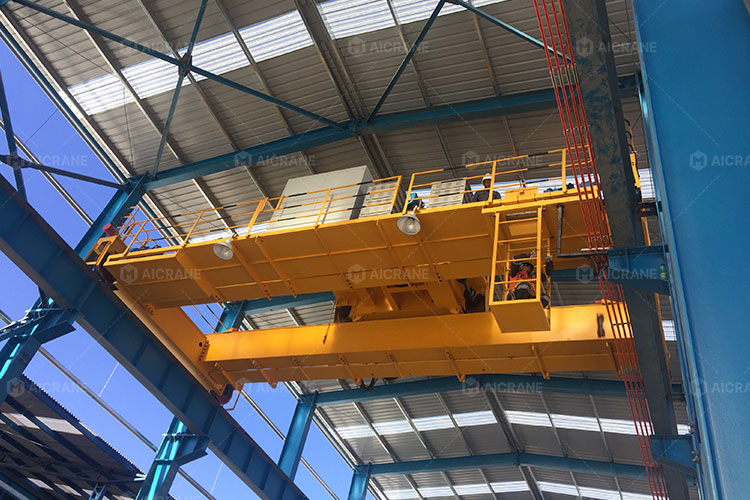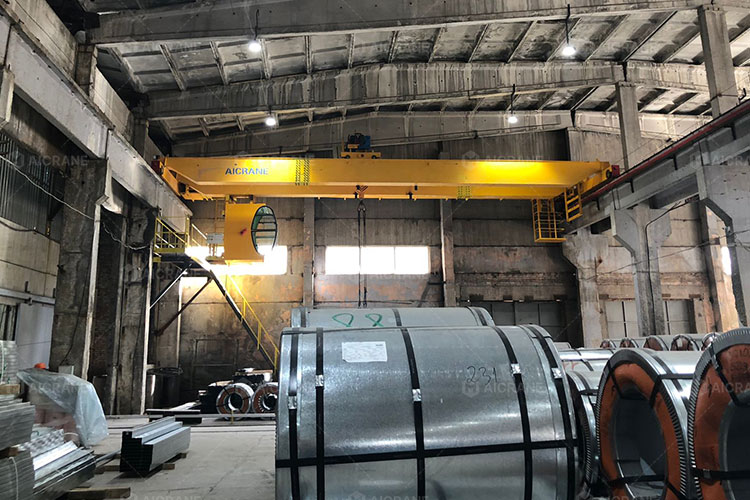Overhead cranes play a crucial role in material handling across a wide range of industries, from manufacturing and warehousing to shipbuilding and power generation. One of the most important structural components of an overhead crane is the main girder, which supports the hoist and trolley and transfers the load to the end trucks and ultimately to the building or supporting structure. Choosing the appropriate beam profile for the crane’s main girder is essential for ensuring structural integrity, operational efficiency, and safety.
This article discusses the key factors involved in selecting beam profiles for overhead crane main girders, compares common beam types, and provides guidelines for optimal selection based on girder overhead crane type, capacity, and application.

Importance of Beam Profiles in Overhead Cranes
The main girder serves as the primary load-carrying element in an overhead crane. It must be designed to resist bending, deflection, and torsion caused by the weight of the hoist, the load, and dynamic forces during operation. The choice of beam profile affects not only the load-bearing capacity but also the weight of the crane, the ease of fabrication, cost of production, and compatibility with other components like the hoist and trolley.
Improper beam selection can lead to excessive deflection, increased stress concentrations, premature wear of components, and in severe cases, structural failure.
Common Types of Beam Profiles
There are several types of beam profiles commonly used in the construction of overhead crane main girders:
1. I-Beam (Rolled Steel Joist – RSJ)
-
Description: I-beams have a cross-section shaped like the capital letter “I” and are typically used in light to moderate load applications.
-
Advantages:
-
Economical for light duty overhead cranes
-
Readily available in standard sizes
-
Easy to fabricate and weld
-
-
Limitations:
-
Limited in strength and stiffness for longer spans
-
Prone to lateral-torsional buckling under higher loads
-
Less efficient in very heavy-duty applications
-
2. Box Girder
-
Description: A box girder is a closed rectangular or trapezoidal hollow section made of welded steel plates.
-
Advantages:
-
High torsional rigidity and bending strength
-
Suitable for long-span and heavy-duty cranes
-
Better resistance to buckling
-
-
Limitations:
-
More complex and expensive to fabricate
-
Heavier than other options for the same span and load
-
3. H-Beam (Wide Flange Beam)
-
Description: H-beams have wider flanges than I-beams, offering more surface area for load distribution.
-
Advantages:
-
Higher load-bearing capacity than I-beams
-
Increased resistance to bending
-
Suitable for moderate to heavy duty overhead cranes
-
-
Limitations:
-
Heavier and more costly than I-beams
-
May require additional bracing in some applications
-

4. Truss Girder
-
Description: A truss girder consists of a framework of interconnected steel members that form a triangular network.
-
Advantages:
-
Lightweight yet strong
-
Ideal for very long spans
-
Easy to transport in segments and assemble on-site
-
-
Limitations:
-
Complicated design and analysis
-
Requires precision fabrication
-
Not suitable for enclosed environments due to dust accumulation
-
Key Selection Criteria for Beam Profiles
Choosing the appropriate beam profile for an overhead crane main girder involves evaluating several interrelated factors:
1. Load Capacity and Crane Duty Class
The most important factor is the maximum load the crane will carry and the frequency of use. Crane classification systems such as CMAA (Class A-F) or FEM help determine the operational duty cycle and stress levels. For higher capacity and frequent usage, box girders or H-beams are preferred due to their superior strength and rigidity.
2. Span Length
As the span increases, the likelihood of deflection also increases. Longer spans require beam profiles that resist sagging and lateral deflection, making box girders or truss girders ideal choices. I-beams are only suitable for short-span, light-duty cranes.
3. Torsional Resistance
Applications involving side pull, skewing loads, or eccentric loads demand high torsional resistance. Box girders excel in such situations due to their closed-section profile that resists twisting.
4. Deflection Limits
Most crane standards specify allowable deflection limits, commonly L/1000 for vertical deflection (where L is the span length). Selecting a profile that minimizes deflection ensures safe operation and prolongs the lifespan of the crane components.
5. Fabrication and Cost Considerations
Beam profiles must also be evaluated from the perspective of fabrication complexity, cost of materials, and labor. I-beams and H-beams are easier and less expensive to fabricate, while box girders offer superior performance at a higher cost.
6. Type of Hoist and Trolley
The hoist configuration (under-running or top-running) and trolley type (open winch, monorail, etc.) influence the selection of beam profiles. Under-running cranes usually use I-beams or H-beams, while top running cranes with heavier trolleys and winches benefit from box girders.
Beam Profile Recommendations by Crane Type
Here are some general guidelines for selecting beam profiles based on common overhead crane types:
1. Single Girder Overhead Cranes
-
Typical Loads: Light to moderate
-
Beam Types: I-beams or H-beams
-
Applications: Warehouses, workshops, assembly lines
2. Double Girder Overhead Cranes
-
Typical Loads: Moderate to heavy
-
Beam Types: Box girders or welded plate girders
-
Applications: Steel plants, power stations, precast concrete yards
3. Underslung Cranes
-
Typical Loads: Light to moderate
-
Beam Types: I-beams or H-beams with running flanges
-
Applications: Low headroom environments
4. Long-Span or Custom Cranes
-
Typical Loads: Medium to heavy with long spans
-
Beam Types: Truss girders or custom box girders
-
Applications: Aircraft hangars, shipyards, large manufacturing plants
Innovations and Optimization Strategies
With modern engineering tools like Finite Element Analysis (FEA) and 3D CAD modeling, beam profiles can now be optimized for maximum strength-to-weight ratios. Some manufacturers use hybrid designs combining different profiles or reinforcement techniques such as:
-
Pre-cambering to counteract deflection
-
Using high-tensile steel for lighter, stronger beams
-
Integrating anti-sway or vibration dampening features
Conclusion
The selection of beam profiles for overhead crane main girders is a critical design decision that directly influences the performance, safety, and cost-effectiveness of the crane system. Factors such as load capacity, span, deflection limits, fabrication cost, and the intended application all play a role in determining the best beam type. While I-beams and H-beams are ideal for light to medium-duty cranes, box girders and truss structures are necessary for heavy-duty and long-span applications.
To ensure optimal selection, it’s important to work with experienced crane engineers and manufacturers who can evaluate the project’s specific needs and apply structural analysis to design the most suitable girder configuration. Investing in the right beam profile not only enhances crane efficiency but also ensures long-term durability and safe operation.
